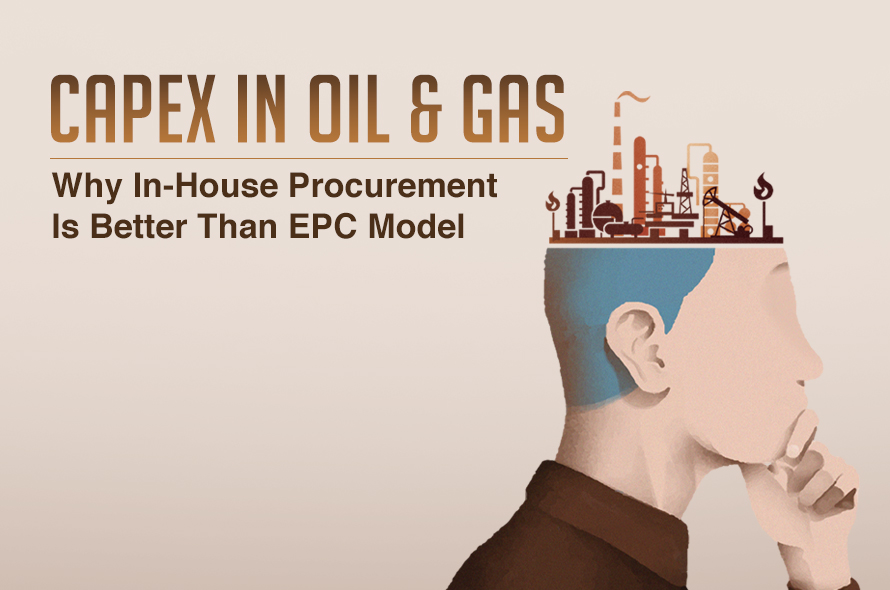The oil & gas industry is facing unprecedented challenges, including volatile prices, fluctuating demand, and the need for greater sustainability. In this environment, effective capex management is essential for O&G companies to succeed. To drive this, they must make bold moves and choose the right model.
In our latest bulletin — Capex in Oil & Gas: Why In-house Procurement Is Better Than EPC Model — discover how in-house procurement scores over the traditional engineering, procurement and construction (EPC) model. In-house procurement allows companies to adapt and thrive in today's dynamic business environment.
What’s Inside:
- Capex trends in the O&G sector
- Benefits of in-house procurement
- Setting up a procurement program management office
This bulletin is a must-read for procurement leaders in the O&G space looking for steps to future-proof their businesses.
The oil and gas (O&G) industry has seen significant changes in recent years, including shifts in pricing, demand fluctuations and advancements in technology. These factors have greatly impacted capital expenditure (capex) trends in the sector, leading many companies to look for a model that considers the industry’s fast-evolving landscape and optimizes investment decisions, operations and longterm sustainability.
With oil prices rebounding, U.S.-based O&G companies have bolstered their capex and spending is expected to touch $105 billion, a 25% increase YoY 1. Capex trends dominating the O&G sector include:
Upstream investments: The upstream segment, which includes exploration and production, typically accounts for the largest share of capex spending. In recent years, many companies have focused their upstream investments on shale oil and gas plays in North America, where production costs are relatively low. For example, ConocoPhillips has several planned greenfield shale oil projects in the Permian Basin, including the Monte Cristo project, which is expected to involve drilling over 300 wells and production of up to 75,000 barrels of oil equivalent per day.
Midstream investments: Midstream investments, which include pipelines and other transportation and storage infrastructure, have also been a focus of capex spending. The expansion of pipeline networks in North America has been a significant driver of midstream investments in recent years. Phillips 66, for example, is planning to build the Gray Oak Pipeline, which will transport crude oil from the Permian Basin to the Gulf Coast.
Downstream investments: Downstream investments, which include refining and marketing, have been far from stable in recent years, with some companies investing in new refineries and others divesting to focus on core upstream activities. BP, for instance, invested $4.2 billion to modernize its Whiting Refinery in Indiana, one of the largest refineries in the United States.
Renewable energy investments: Many companies are investing in renewable energy technologies, such as solar, wind power and carbon capture as part of a broader shift toward a lower-carbon energy mix. For example, Shell is planning to develop onshore wind projects in the U.S., including the 480MW Cedar Creek II project in Colorado and the 250MW Horse Creek project in Illinois.
Capex trends play a significant role in determining procurement decisions. Traditionally, O&G companies have relied on engineering, procurement and construction (EPC) companies to manage the procurement process for greenfield capital projects.
However, managing procurement in-house can allow companies to exercise greater control over costs and lower the overall project cost as well as deliver significant value to consumers.
The Cost of a Greenfield Capital Project
It is important to understand the costs of a greenfield project before considering in-house procurement as an option for your organization. The below table showcases the different cost components of a greenfield oil refinery project:
1.Site preparation and civil works: This includes the cost of acquiring the land, preparing the site for construction and any necessary environmental remediation. It also includes the cost of building the foundation, roads, and other infrastructure necessary for the construction and operation of the refinery.
2.Equipment and materials: This includes the cost of purchasing and transporting all the equipment and materials needed to build the refinery, such as turbines, generators, boilers and other components.
3.Installation and labor: This includes the cost of installing the equipment and materials, as well as the cost of labor for the construction and commissioning of the refinery.
4. EPC fee: This includes the cost of managing the project, procurement and the cost of engineering services required to design and construct the refinery.
5. Contingency costs: These are additional costs that may be incurred if unexpected issues arise during the construction process, such as cost overruns, schedule delays, or additional regulatory requirements.
Benefits of In-House Procurement
There are several benefits to taking procurement in-house:
1. EPC fee reduction: EPC companies typically charge a fee of around 10% on the overall project cost including procurement. By taking procurement in-house, O&G companies can save a part of this fee and ensure significant cost savings.
2. Procurement excellence: By managing procurement in-house, companies can leverage their existing supplier base to negotiate better prices.
Companies can also optimize design requirements through design to value, utilize off-the-shelf specifications, leverage refurbished parts wherever possible, consolidate spend with incumbent suppliers, negotiate volume rebates, eliminate mobilization and demobilization costs, leverage non-OEM suppliers for balance of refinery equipment and electrical parts, and negotiate incentives to ensure delivery on time in full (OTIF).
3. Contingency reduction: : Companies can reduce contingency from 10% to 3% of the budget by setting up a dedicated program management office. This can lead to significant cost savings and improve overall project management.
By eliminating EPC margins on material and equipment procurement, leveraging existing supplier base, driving procurement excellence and reducing contingency costs, O&G companies can save up to 20% of the overall project costs and deliver enormous value to end consumers.
However, in-house procurement is not without risks. Coordinating with multiple entities can lead to quality risks, delays, cost overruns and complexities while dealing with equipment damages. Cost escalation is a constant threat because of factors like inflation, variations in design and supplier price increases. Regulatory risks may also arise due to delays in approvals, leading to reputational damage and potential legal repercussions.
All these risks can be mitigated by negotiating relevant contractual terms, leveraging existing insurance and specialist consultants, and setting up a dedicated program management office.
Procurement Program Management Office
A dedicated procurement program management office (PMO) must be set up with key responsibility areas such as governance, reporting, and performance management, operational delivery management, and stakeholder/relationship management. This office can ensure that risk mitigation measures are implemented across all areas and drive program excellence.
Handling procurement in-house for greenfield capital projects is a smart business decision for several reasons. It enables the organization to have greater control over the procurement process and ensures the quality standards and costs are in line with expectations. However, it’s important to weigh the pros and cons before making a decision and have a clear procurement strategy and a talented internal team in place to ensure success.
Notes
- Tajinder Dhillon, U.S. Oil Production and Capex Expected to Rise, Refinitiv, 21 June 2022 | https://lipperalpha.refinitiv.com/2022/06/u-s-oil-production-and-capex-expected-to-rise/
Turn ideas into action. Talk to GEP.
GEP helps enterprise procurement and supply chain teams at hundreds of Fortune 500 and Global 2000 companies rapidly achieve more efficient, more effective operations, with greater reach, improved performance, and increased impact. To learn more about how we can help you, contact us today.

JASON ALLUKIAN
Senior Director, GEP
Jason is responsible for managing large-scale strategic sourcing and supply chain projects in the energy and utility sectors at GEP. His areas of expertise include supply chain transformation, procurement, operations and maintenance strategy, negotiations, category management and supplier management. Prior to GEP, he worked with a consulting firm, leading client-facing teams to develop and execute sourcing strategies of over $15 billion for Fortune 500 energy companies.
LET'S CONNECT

